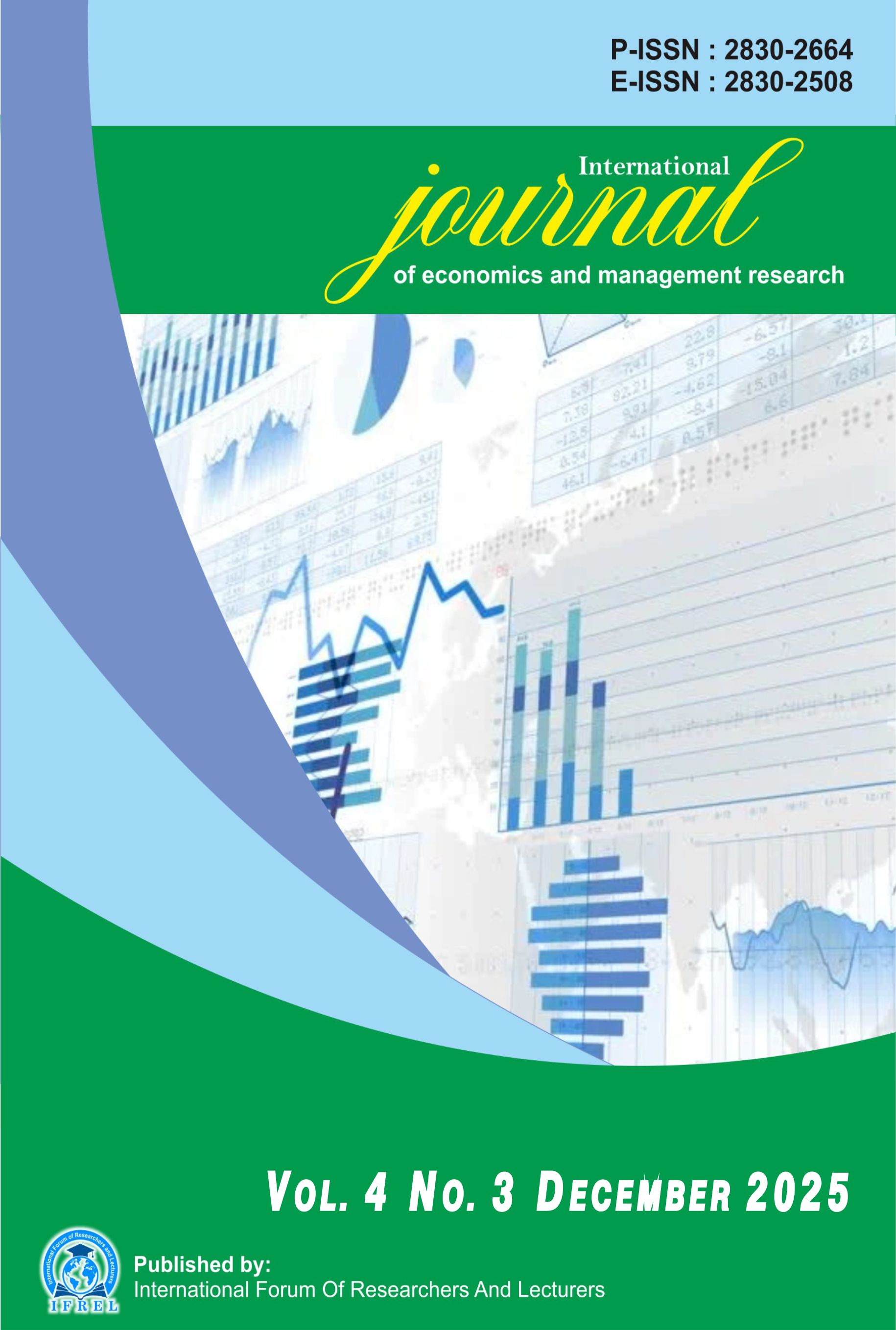Building Digital Resilience: Exploring the Narratives of Micro-Entrepreneurs in Technology-Based Financial Transformation in Semarang City
DOI:
https://doi.org/10.55606/ijemr.v4i3.602Keywords:
Digital Financial Tools, Digital Literacy, Financial Distress, Financial Restructuring, Micro-enterprisesAbstract
This study focuses on designing a technology-based financial restructuring model to address the challenges faced by micro-enterprises in Semarang, particularly in financial management. Micro-enterprises play a vital role in the local economy but often struggle with liquidity issues, delayed payments, and weak receivable management, which increase their vulnerability to financial distress and potential bankruptcy. The research used a qualitative case study approach, combining in-depth interviews with 20 micro-entrepreneurs, five financial experts, participatory observations in 10 businesses, and three Focus Group Discussions (FGDs) involving entrepreneurs, fintech providers, and banking representatives. The data were analyzed using thematic coding, SWOT, and gap analysis to identify financial distress patterns and develop a restructuring prototype through design thinking. The results showed that 80% of MSMEs in Semarang face medium to high financial distress risk, with only 40% using digital tools for financial recording. The findings reveal a significant gap, as 60% of MSMEs still rely on manual methods. The study suggests that integrating basic financial applications and providing digital literacy training can enhance efficiency, decision-making, and resilience. The proposed financial restructuring model addresses both digital solutions and literacy barriers, ensuring practical adoption by micro-entrepreneurs.
References
Ando, R., Kawamata, Y., Takeda, T., & Okada, Y. (2024). An explainable framework based on counterfactual explanations for multi-class financial distress prediction of small and medium enterprises. Proceedings - 2024 IEEE International Conference on Big Data (BigData 2024), 2269–2274. https://doi.org/10.1109/BigData62323.2024.10825908
Anggita, S., Sunarmi, S., Azwar, T. K. D., & Sukarja, D. (2023). Restrukturisasi perusahaan yang mengalami financial distress melalui merger. Jaksa: Jurnal Kajian Ilmu Hukum dan Politik, 1(4), 37–48.
Ardiagarini, S. (2011). Analisis dampak merger dan akuisisi terhadap kinerja keuangan perusahaan target [Undergraduate thesis, Universitas Diponegoro]. Fakultas Ekonomi, Universitas Diponegoro Semarang.
Aryaningtyas, A. T., & Palupiningtyas, D. (2017). Pengaruh pendidikan kewirausahaan dan dukungan akademik terhadap niat kewirausahaan mahasiswa. Jurnal Ilmiah Manajemen dan Bisnis, 18(2), 140–152. https://doi.org/10.30596/jimb.v18i2.1398
As’ari, H. (2015). Analisis pengaruh restrukturisasi keuangan terhadap kinerja perusahaan. JRAMB, 1(2). https://doi.org/10.26486/jramb.v1i2.170
Azhou, Y. (2021). Dynamic analysis of the prediction of financial difficulties in enterprise financial management. Proceedings of SPIE - The International Society for Optical Engineering, 12128, 1212815. https://doi.org/10.1117/12.2625006
Bisht, D., Singh, R., Gehlot, A., Akram, S. V., Singh, A., Montero, E. C., Priyadarshi, N., & Twala, B. (2022). Imperative role of integrating digitalization in the firms finance: A technological perspective. Electronics (Switzerland), 11(19), 3252. https://doi.org/10.3390/electronics11193252
Cholik, C. A. (2021). Perkembangan teknologi informasi komunikasi/ICT dalam berbagai bidang. Jurnal Fakultas Teknik Kuningan, 2(2), 39–46.
Di Pietro, R., Raponi, S., Caprolu, M., & Cresci, S. (2021). FinTech. In Advances in Information Security (Vol. 84, pp. 99–154). Springer. https://doi.org/10.1007/978-3-030-60618-3_4
Gouillart, F. J., & Kelly, J. N. (1995). Transforming the organization. McGraw-Hill.
Helmold, M., & Dathe, T. (2020). Negotiations in companies with financial difficulties. In Management for Professionals (pp. 201–213). Springer. https://doi.org/10.1007/978-3-030-33483-3_14
Hijrasil, H., Maisharah, S., Widodo, Z. D., Darsono, D., & Manuhutu, H. (2023). Penerapan teknologi HRIS (Human Resource Information System) dalam meningkatkan efisiensi dan efektivitas manajemen SDM. Jurnal Pendidikan Tambusai, 7(2), 7074–7085.
Ishak, S. S., Ilias, M. R., Nayan, A., Abdul Rahim, A. H., & Morat, B. N. (2024). Logistic regression model for evaluating performance of construction, technology and property-based companies in Malaysia. Journal of Advanced Research in Applied Sciences and Engineering Technology, 39(2), 72–85. https://doi.org/10.37934/araset.39.2.7285
Karim, A. (2016). Dakwah melalui media: Sebuah tantangan dan peluang. At-Tabsyir: Jurnal Komunikasi Penyiaran Islam, 4(1).
Lestari, S. (2018). Peran teknologi dalam pendidikan di era globalisasi. EDURELIGIA: Jurnal Pendidikan Agama Islam, 2(2), 94–100. https://doi.org/10.33650/edureligia.v2i2.459
Nasution, M. I. P. (2014). Keunggulan kompetitif dengan teknologi informasi. Jurnal Elektronik.
Nga, D. Q., Pham, D. L., Nguyen Tran, C. L., & Pham, T. H. (2018). Corporate restructuring: Case study in Vietnam. Academy of Accounting and Financial Studies Journal, 22(5).
Norley, L., Swanson, J., & Marshall, P. (2012). A practitioner’s guide to corporate restructuring. City Planning Publishing.
Palupiningtyas, D., Mistriani, N., & Wijoyo, T. A. (2020). Analisis lingkungan internal dan eksternal pariwisata dalam meningkatkan ekonomi masyarakat lokal di Kabupaten Demak Jawa Tengah. Jurnal Manajemen STIE Muhammadiyah Palopo, 6(1), 43–49. https://doi.org/10.35906/jm001.v6i1.496
Platt, H. D., & Platt, M. B. (2006). Understanding differences between financial distress and bankruptcy. Review of Applied Economics, 2(2).
Portovaras, T., Kyrychenko, V., Tsepkalo, T., Sokulskyi, O., & Krysovatyy, I. (2024). The role of modern information technologies in financial analysis and market forecasting. Economic Affairs (New Delhi), 69(1), 735–742. https://doi.org/10.46852/0424-2513.2.2024.34
Pranata, S. P., & Sinaga, A. (2023). Analysis of brand awareness and brand image strategies on Lake Toba tourists’ interest through the F1H20 power boat digital marketing strategy in Balige, North Tapanuli. Journal of Business Management and Economic Development, 1(2), 240–249. https://doi.org/10.59653/jbmed.v1i02.137
Rivai, A., Pranata, S. P., Fadila, Z., Syahlina, M., & Ginting, B. B. (2021). The effect of facilities on motivation and its impact on accounting understanding. International Journal of Science, Technology & Management, 2(6), 1934–1938. https://doi.org/10.46729/ijstm.v2i6.368
Sharma, V., Grover, N., Kathuria, S., Singh, R., Dhyani, A., & Pandey, P. S. (2023). Integrating digitalization role to play in financial management. 2023 International Conference on Computational Intelligence, Communication Technology and Networking (CICTN 2023), 82–86. https://doi.org/10.1109/CICTN57981.2023.10141221
Situm, M. (2023). Factors affecting micro and small business distress in Austria. International Journal of Entrepreneurial Venturing, 15(1), 19–62. https://doi.org/10.1504/IJEV.2023.129277
Soegiono, S. L., & Sutanto, E. M. (2013). Restrukturisasi Organisasi di PT Samudra Alam Raya Surabaya. Agora, 1(3).
Sunarmi, S., & Hidayat, I. (2022). Analisa perancangan simpan pinjam pada Bank Perkriditan Rakyat berbasis client server. Jurnal Publikasi Ekonomi dan Akuntansi, 1(1), 22–33. https://doi.org/10.55606/jpmi.v1i1.76
Sunarmi, S., Supriyadi, A., Guritno, B., & Kuntariningsih, A. (2024). Penerapan teknologi dalam manajemen sumber daya pengelolaan keuangan: Studi pada CV. Landel Elektrik Semarang. Jurnal Ilmiah Komputerisasi Akuntansi, 17(1), 477–484.
Surya, S. S. (2014). Akibat hukum bentuk-bentuk restrukturisasi perusahaan di Indonesia. Jurnal Hukum Universitas Udayana.
Wang, D. (2022). Research on the application of computer technology in financial management. Proceedings of SPIE - The International Society for Optical Engineering, 12331, 123315K. https://doi.org/10.1117/12.2653087
Downloads
Published
How to Cite
Issue
Section
License
Copyright (c) 2025 International Journal of Economics and Management Research

This work is licensed under a Creative Commons Attribution-ShareAlike 4.0 International License.







